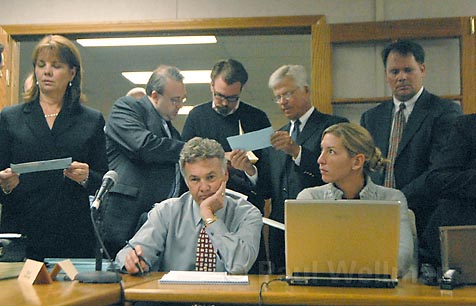Rincon Septic-to-Sewer Plan Approved
Brown Out

The normally sleepy proceedings of the Carpinteria Sanitary District Board of Directors exploded this week as multimillion-dollar-home
owners, their lawyers, and surfers descended on the scene looking to change what happens when toilets get flushed along Rincon Point.
For years, people have been getting sick after surfing the world-class waves of Rincon, often blaming their fevers, sore throats, ear infections, and stomach problems on the septic tanks that service the 72 homes in the gated Rincon Point community on the popular Carpinteria point break. Led by Santa Barbara nonprofit Heal the Ocean, a plan has been in motion for the better part of nine years to convert the individual septic tanks to a comprehensive sewage system under the jurisdiction of the Sanitary District. Tuesday, October 16, marked the final step in that long process: a tally of votes from Rincon Point homeowners as to whether or not they support the conversion.
Tensions have been running high in recent weeks, with enviros, surfers, and area residents engaged in a divisive battle of mudslinging and scientific pissing matches leading up to this week’s vote counting as well as an increasing number of people calling foul on the project’s ability to impact the water quality along the point. In the end, needing only a simple majority approval to succeed, the plan-after more than three hours of highly scrutinized deliberations-got just that and then some.
According to the “unofficial” results, 41 of the 72 property owners voted in favor of the septic-to-sewer switch. Upon hearing the uncertified results, Heal the Ocean executive director Hillary Hauser was visibly emotional about what, to her, is a bittersweet victory: “After all these years I always imagined a big celebration on this day but instead, because of all this negativity and the accusations, it just seems so sad right now.”
The road to Tuesday night began back in 1999 when a DNA test of Rincon Creek waters found traces of human fecal matter in the downstream stretches near the river mouth and near the septic-serviced residences, while no such pollution was found upstream, away from the houses. Though the same study also fingered animal waste, urban runoff, and general upstream watershed pollution as the key contributors to the dirty water, most surfers, Heal the Ocean members, and area residents blamed the septic tanks. “This all started with the surfers,” Hauser recalled. “If it weren’t for them and their concerns, none of this would have happened.” In the many years since, the grassroots plan, aimed at improving water quality via lawsuits, widespread fundraising, and countless public hearings, slowly became a reality.
But not everyone living in the beachfront community is convinced that what will be a required conversion-costing an estimated $80,000 per household-will result in cleaner water. Billy Taylor and his wife, Brooke-both avid surfers relatively new to the Rincon community-are leading the charge of an increasingly vocal opposition that feels the conversion will do little to improve water quality. “Look up and down the California coast. You have the same water problems everywhere regardless of septic systems. I guarantee people will continue to get sick in the lineup at Rincon,” Billy said. “And then what? There is a reason why no one is making a guarantee that this thing is going to work.”
To Billy and the others in the community who voted against the plan, the fact that the sewage will still be pumped into the ocean-albeit in a chemically treated form via a Sanitary District outfall pipe-some 1,000 feet offshore of Rincon is reason enough to rethink the proposal. Add to that the realities of the runoff-producing landscape and the fact that the conversion could potentially pave the way for additions on a number of the Rincon Point homes, and you have what one area resident referred to at the meeting as “an expensive proposition with very questionable results.”
Despite the concerns, the plan was not just approved by a majority of Rincon residents but also a majority of landowners from Carpinteria coastal neighborhoods along Padaro Lane, Sand Point Road, and Sandyland Cove. All four communities chose to form the new sanitary assessment district and thus undergo the septic-to-sewer swap. That is, of course, if none of the lawyers on hand at the meeting prove successful in filing objections. To that end, the Sanitary District is scheduled to meet again on October 19 for final verification of Tuesday’s ballots to ensure accuracy before returning to the board in early November for procedural approval of the tally.



